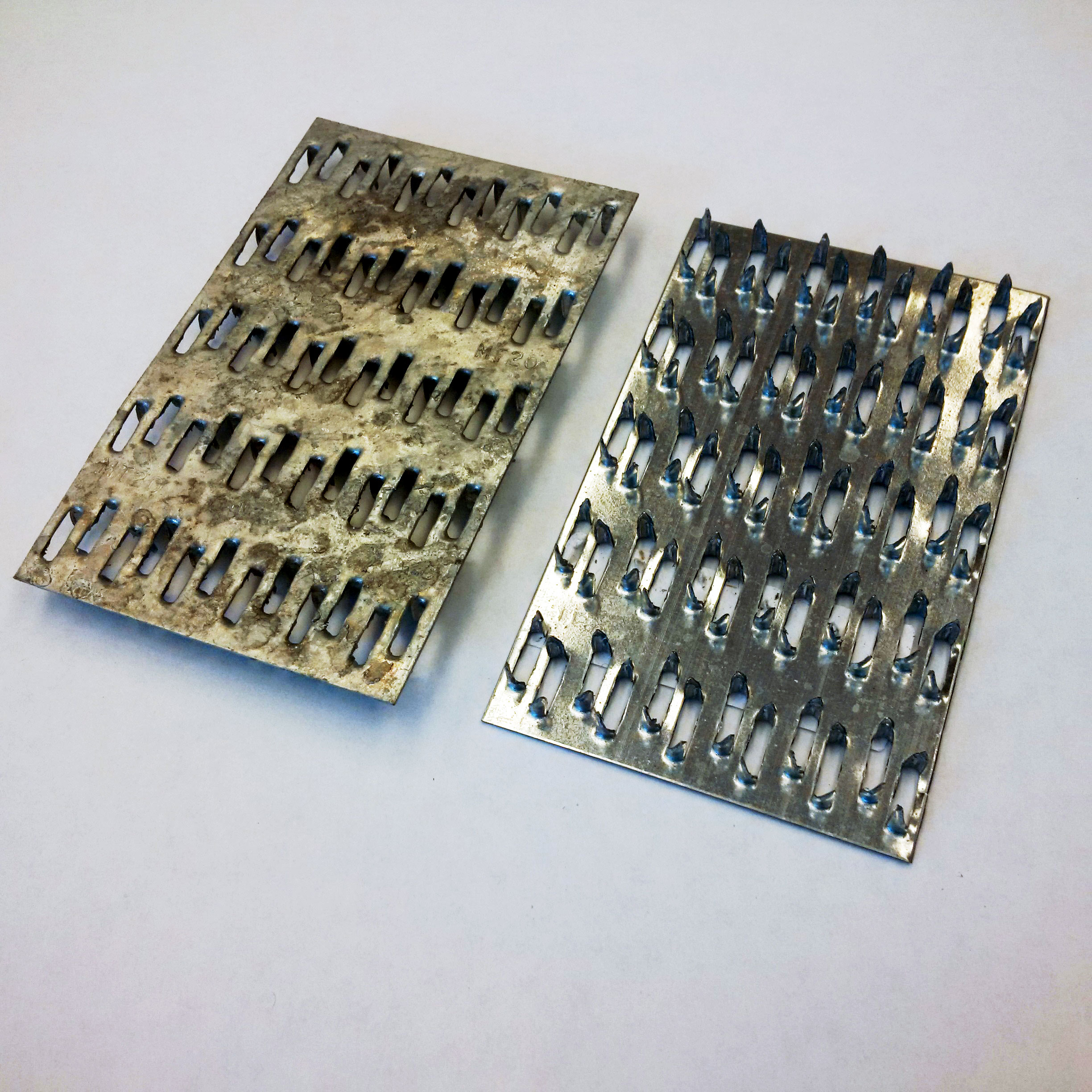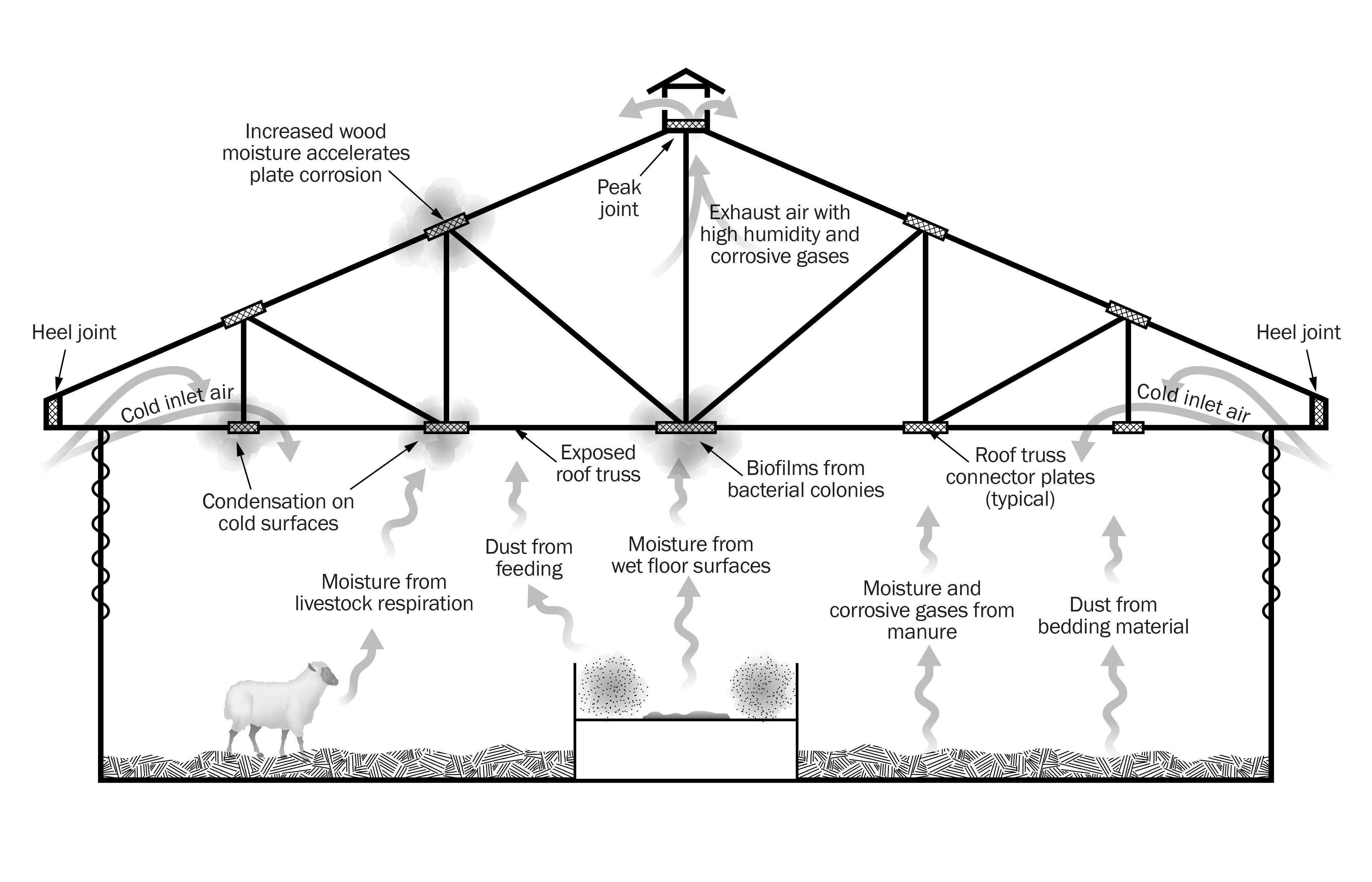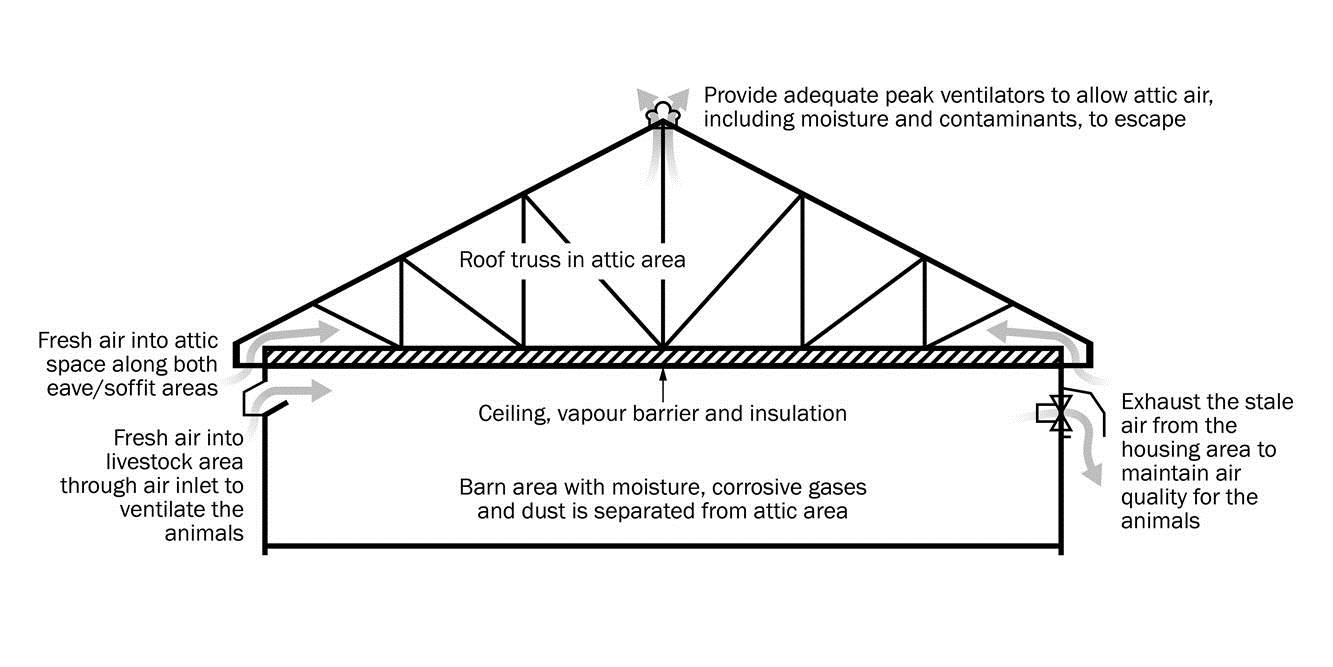
Source: OMAFRA
Introduction
This factsheet describes the common causes of corrosion of roof truss connector plates, practical preventative measures for the construction of new farm buildings and repair options for corroded connector plates in existing buildings.
The corrosion problem
Corrosion of roof truss connector plates is a major concern in farm buildings that contain high humidity, corrosive environments and dust. Inadequately protected connector plates exposed to moisture and ventilation air (containing manure gases and other corrosive agents) will corrode rapidly. The connector plates in many of these buildings show severe corrosion within 5–10 years.
Building owners, designers and contractors must provide protection for these connector plates to reduce or eliminate the potential for corrosion. The corrosion can weaken the plates and potentially lead to structural failure, including collapse. Protecting the connector plates can also safeguard the significant investment made to construct a farm building by increasing the lifespan of the roof structure.
Roof truss connector plates
Prefabricated light-framed wood roof trusses are commonly used in the construction of farm buildings. The connector plates are light-gauge metal plates used to connect the truss members. The connector plates are a proprietary product, produced by punching galvanized sheet steel to create a specific number of protrusions or teeth on one side of the sheet. An example connector plate is shown in Figure 1. The sheet steel used to produce the connector plates is normally available in thicknesses between 16–20 gauge. During wood truss fabrication, the connector plates are pressed into the lumber using a hydraulic press or roller to fully embed the teeth.

Causes of connector plate corrosion
Inadequately protected connector plates will corrode when exposed to moisture, corrosive agents and dust. Moisture in the barn comes from humidity in the ventilation air and condensation on cold surfaces. It also comes from livestock when they exhale, pant or sweat, or from the ground in farm buildings with dirt floors. Moisture is evaporated from manure and wet floor surfaces inside the building.
Corrosive agents like ammonia are found in confined livestock environments. Ammonia gas combines with moisture and becomes ammonium hydroxide, a chemical that attacks most metal surfaces. An increase in the moisture content of the wood in the truss can accelerate corrosion of the connector plates because of the natural acidity of wood. Other corrosive agents are produced from stored products on the farm, like fertilizer and chemicals. Common bacterial colonies found in farm buildings tend to form biofilms on building and equipment surfaces, allowing production of other corrosive acids.
Dust is common in many farm buildings. Dust provides a surface on which acids and gases can react. This significantly accelerates the rate of corrosion on any metal surface.
Livestock barns and roofed manure storages without ceilings are often affected by corrosion. These buildings allow moisture, corrosive gases and dust direct access to the trusses and connector plates (Figure 2). The connector plates often show the greatest deterioration near the building air exchange openings, at the heel and peak joints of the truss. These are the areas of significant air mixing and temperature changes, coupled with high humidity and corrosive gas concentrations, producing ideal conditions for corrosion. The heel and peak joints are critical to the structural integrity of the trusses.
Prevention of corrosion in new construction
When constructing a new farm building, it is important that owners and designers assess the expected service conditions in the completed building. If the connector plates will be exposed to moisture, corrosive gases or dust during the life of the building, then use corrosion prevention methods. As shown in Figure 2, the connector plates in an unheated sheep barn where the trusses are exposed (no ceiling) requires corrosion protection. These plates are exposed to moisture from animal respiration and ventilation air, moisture and corrosive gases from the manure pack and dust from feeding and bedding. Conversely, the plates in a machinery storage building with a concrete floor, insulation to prevent condensation and sufficient ventilation would not likely require any corrosion protection. In this case, it is not expected that moisture, corrosive gases or dust will be present in any significant amounts. A similar assessment is also required for a change of use, where an existing building is re-purposed to another function.
Careful assessment of the expected service conditions will lead to appropriate corrosion prevention methods, some of which are described in the following sections. Appropriate prevention measures will ensure structural safety and longevity of the roof structure.

Properly ventilate and insulate the building
A good ventilation system should move enough fresh air through the building to reduce the amounts of moisture, gas and dust to acceptable levels. Provide a sufficient amount of insulation to prevent condensation. A well-designed system will minimize corrosion problems. Proper ventilation requires good building design and good ventilation management. A ventilation specialist, equipment supplier or building contractor can help ensure that ventilation issues will not contribute to a corrosion problem.
Often, an owner seals up the barn or changes the ventilation controller settings to reduce the requirement for supplemental heat during colder weather. Unfortunately, any reduction of the minimum ventilation rate will cause the humidity level to increase. In fan-ventilated barns, operate stage one exhaust fans continuously to remove the respired moisture and contaminants. Similarly, naturally ventilated barns require a constant exchange of air to control moisture. Never completely close chimneys or continuous ridge openings.
Barns with continuous ridge ventilation provide a condensing surface at every truss peak connection along the barn. Provide additional protective measures in these areas. Alternatively, situating chimneys intermittently between the trusses may keep this moist ventilation air away from the truss plates and reduce the potential for corrosion.
Install a ceiling with insulation and a vapour barrier
If the truss assembly is completely separated from the livestock environment, as shown in Figure 3, it will not be influenced by the moisture, corrosive agents and dusty conditions that cause corrosion. A minimum 6-mil polyethylene vapour barrier with the seams taped will limit moisture migration into the attic space. Typical steel or plywood ceilings by themselves do not provide an adequate vapour barrier — the sheet seams, fasteners and material porosity will allow moisture to pass through. A minimum amount of ceiling insulation is also required to prevent condensation from occurring on the ceiling surface.

Ventilate the attic area to allow moisture to escape and allow fresh air to enter along both the eave and soffit areas. The building in Figure 3 uses vented soffit at the eaves and chimneys at the peak to ventilate the attic space. Note that in fan ventilated facilities with attic/ceiling air inlets, the minimum ventilation rates must be sufficient to ensure warm, moist inside air is not drawn into the attic space through the room inlets. For more information, see the Ontario Ministry of Agriculture, Food and Rural Affairs Publication 833, Ventilation for Livestock and Poultry Facilities, and consult a designer or builder for the appropriate number and sizing of components.
Use galvanized metal connector plates
Normal or standard connector plates are fabricated from sheets that are hot-dip galvanized to Coating Designation G90 in accordance with ASTM A924 Standard Specification for Steel Sheet, Zinc-Coated (Galvanized) or Zinc-Iron Alloy-Coated (Galvanealed) by the Hot-Dip Process. These plates are not suitable for use in buildings where service conditions will include moist, corrosive and dusty environments. Consider these plates as unprotected with respect to corrosion.
Some additional protection for limited corrosive environments is provided by using plates with Coating Designation G185. The designer should check with the plate manufacturer or truss supplier to ensure these plates are available and the level of corrosion resistance provided. Since the punching process to fabricate the plates also exposes unprotected edges of the teeth, insist on hot-dip galvanizing the plates after fabrication.
Apply a protective paint to metal connector plates
Apply a protective paint system to the connector plates either before or after truss installation. This type of protection is applied on site at the time of truss installation using airless spray, brush or roller. The recommended paint system is a Coal Tar Epoxy-Polyamide system conforming to SSPC Paint No. 16 (SSPC refers to the Society for Protective Coatings). A truss manufacturer or industrial paint supplier can help find this product. Painting can be undertaken by a commercial painter, building contractor or the owner. However, it is a labour-intensive job that will only be as effective as the extent of surface preparation and the quality of workmanship employed. This paint system is a two-component product that requires specific mixing and application expertise. Carefully follow the paint manufacturer’s recommendations for surface preparation, mixing and application, and ensure to cover each connector plate, including its edges, with the coating.
Some manufacturers offer connector plates with a factory-applied proprietary protective paint, or pre-coated truss plates. These plates may be larger due to their slippery surface, depending on the manufacturer’s specific product. In addition, because the plates are coated before truss manufacture, they may get chipped during shipping to the building site or during installation. This creates opportunities for corrosion. The effectiveness of this protective coating needs to be protected from the factory through to final installation.
Use stainless steel truss plates
Stainless steel plates are also available from many manufacturers. Not all suppliers stock these plates, so factor in delivery time. These plates tend to be larger than galvanized plates due to their slippery surface and the limited thicknesses available. Though they are more expensive than galvanized plates, stainless steel plates are durable because they do not rely on a coating for corrosion resistance.
Repair in existing farm buildings
Similar to new construction, it is important to address any sources of moisture, corrosive agents and dust in an existing building showing signs of connector plate corrosion. Once the service conditions of the truss system are assessed, determine the appropriate repair strategies.
If existing truss connector plates are showing only minor corrosion, options for repair include:
- properly ventilating the building
- installing a ceiling with insulation and vapour barrier
- applying a protective paint system or
- providing a combination of these repair options
Each of these repair options are described in detail in the previous section for new construction. Note that the protective paint system installation may be difficult in an existing building due to the surface preparation required for proper application. As the roof trusses are already in place, access to the truss plates and working heights can be a challenge. In some cases, ventilation, insulation and ceiling installation may be more cost effective.
If existing truss connection plates are significantly corroded, or if unsure of the amount of corrosion, have a professional engineer conduct an assessment and prepare an appropriate repair specification. In some cases, replacement of the roof truss system is required to ensure that the building is safe.
Summary
While the extent of the truss connector plate corrosion problem is not known, it is a very serious situation for those buildings affected.
For new construction and significant renovations, carefully consider the expected service conditions of the roof truss system and use appropriate corrosion prevention measures. Though some prevention measures may require additional capital cost, the life-cycle cost of the building tends to be lower due to increased service life and lower maintenance costs.
For existing buildings, inspect buildings periodically for signs of wetness and corrosion on the connector plates. Initiate a repair if necessary. A building contractor, truss manufacturer or professional engineer can assist. The building repair or retrofit expenditure undertaken now will most likely be cheaper than replacing the structure prematurely.
This fact sheet was revised by Steve Beadle, P.Eng., sheep & swine housing, OMAFRA, and reviewed by Dan Ward, P.Eng., poultry & other livestock housing & equipment, OMAFRA, and Vicki Hilborn, P.Eng., civil systems, OMAFRA.








